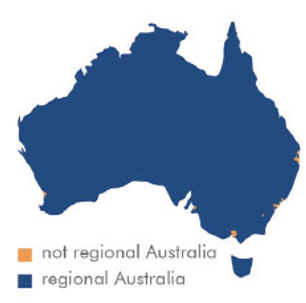Lee Pugalis, Professor of Urban Studies
Institute for Public Policy and Governance, University of Technology Sydney
Australia is the planet’s sixth largest country, which comprises a land area of about 7.692 million square kilometres. Accommodating a population approaching 25 million, Australia’s population distribution is predominantly and, increasingly, urban: approximately 60 per cent of people are located in the five ‘big’ state capital cities of Adelaide, Brisbane, Melbourne, Perth and Sydney. Moreover, 40 percent of the nation’s population reside in Melbourne and Sydney and new research indicates that these two cities generated almost 69 per cent of national Gross Domestic Product growth during 2016-17. Consequently, spatial economic development policy attention is principally city-focussed, informed by an agglomeration boosterism narrative that scripts the state capital cities as (almost exclusive) engines of growth and prosperity. This engenders important implications for regional Australia, which refers to all those places outside of the state capital cities.

In the past, the proclivity of city-based policymakers has been to draw upon generalised portrayals of Australian regions (ie all of non-metropolitan Australia) as spaces of decline. This birdseye view of regional Australia is blinded to the particularities of regions, including their distinctice endownments, potential and interconnections with cities. As Robyn Eversole observes in her book about ‘being regional’, Australian regions are all too often framed through a deficit lens by what they are not and what they lack: ‘The cultural logic of regional development in Australia is that the nation’s non-metropolitan regions need development because their economies, communities, and physical environments are potentially in grave jeopardy’. Therefore, in Australia there exists a sharp divide between urban policy and regional policy.
Government support for the development of regional Australia has a chequered history. Over recent times, the federal government has launched repeated regional policy experiments. Yet, there is limited consensus regarding the practicalities of undertaking regional development, especially as many past approaches have failed to engender lasting positive change. This year has been a busy period for regional policy reformers, with a litany of activities concerned with the regional problem. These include the Select Committee on Regional Development and Decentralisation’s Inquiry into regional development and decentralisation, the Australian Government response to the Independent Review of the Regional Development Australia Program, establishment of the Regional Australia Ministerial Taskforce and publication of the policy statement Regions 2030: Unlocking Opportunity in Regional Australia.
For too long, regional development policy in Australia has been highly politicised, tokenistic, top-down, infrastructure-driven and short-termist. Its politicisation has stifled cooperation between each tier of government (local, state/territory and federal) as well as collaboration with social and economic actors. This situation has spawned a fragmented and chaotic institutional and policy environment, which has resulted in a wide-range of competing regional structures jostling for position in terms of governance, planning and delivery.
Regions 2030 is a rather anaemic document – largely a collation new and existing federal government grant funding initiatives – which falls well short of a national strategy for regional development. However, it sends out a positive message that the development of regional Australia is a priority of the federal government and refers to government’s intent to move away from a ‘one-size-fits-all’ approach to regional policy. There is also an appreciation of the contribution of regions to national prosperity and an understanding that they are fundamental to the functioning of cities, including the suppliers of much of the ‘necessities of everyday life’. Such a tentative recognition of urban and regional interrelationships and interdependencies could provide the basis for a fuller consideration of the urban-regional interface, which might result in new policies with the goal of empowering regions.